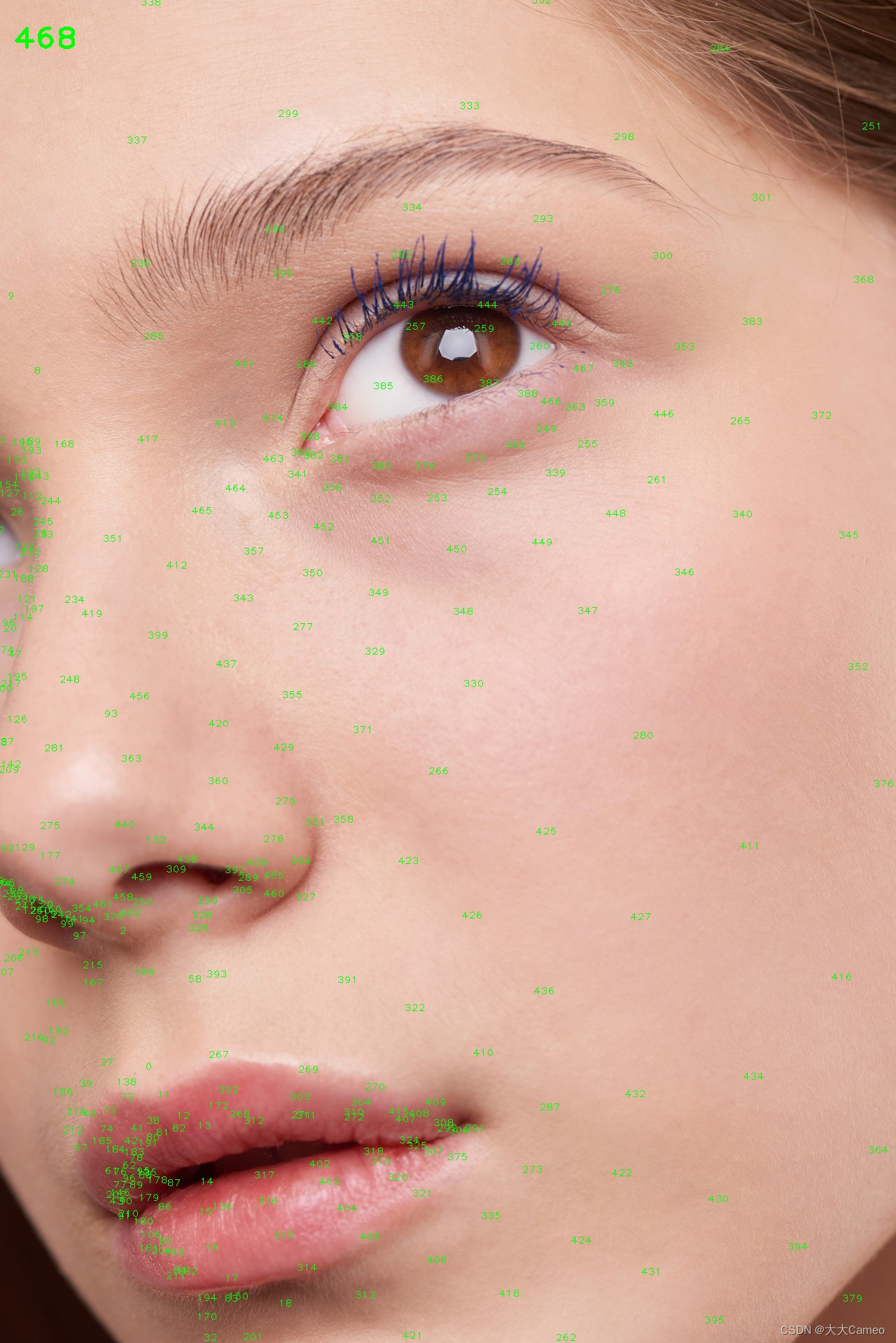一、前言
项目简介:使用OpenCV,实时检测人眼,并实现眨眼计数。
在之前的《OpenCV人脸特征点检测》中,我们了解到人脸由468个特征点构成,如下图所示:



由此可得人眼的坐标信息,然后根据坐标可以实时检测人眼。
二、实战
(1)安装环境
pip install opencv-python
pip install cvzone==1.5.6
pip install mediapipe==0.8.3.1(2)OpenCV加载视频
import cv2
cap = cv2.VideoCapture('Videos/2.mp4') #加载视频
while True:
success, img = cap.read() #读取视频
img = cv2.resize(img, (640, 360)) # 设置视频高、宽
cv2.imshow('Image', img)
cv2.waitKey(1)
(3)捕捉人眼
使用cvzone的FaceMeshDetector方法,可快速检测到人眼,代码如下:
import cv2
import cvzone
from cvzone.FaceMeshModule import FaceMeshDetector
cap = cv2.VideoCapture('Videos/2.mp4') # 加载视频
detector = FaceMeshDetector(maxFaces=1) # 创建检测器
idList = [22, 23, 24, 26, 110, 157, 158, 159, 160, 161, 130, 243] # 左眼坐标
color = (255, 0, 255)
while True:
success, img = cap.read() # 读取视频
img, faces = detector.findFaceMesh(img, draw=False)
if faces:
face = faces[0]
for id in idList:
cv2.circle(img, face[id], 20, color, cv2.FILLED) #标定左眼
img = cv2.resize(img, (640, 360)) # 设置视频高、宽
cv2.imshow('Image', img)
cv2.waitKey(1)效果:

(4)连线
连接眼睛上下、左右四点,输出两点间的距离
import cv2
import cvzone
from cvzone.FaceMeshModule import FaceMeshDetector
cap = cv2.VideoCapture('Videos/2.mp4') # 加载视频
detector = FaceMeshDetector(maxFaces=1) # 创建检测器
idList = [22, 23, 24, 26, 110, 157, 158, 159, 160, 161, 130, 243] # 左眼坐标
color = (255, 0, 255)
while True:
success, img = cap.read() # 读取视频
img, faces = detector.findFaceMesh(img, draw=False)
if faces:
face = faces[0]
for id in idList:
cv2.circle(img, face[id], 20, color, cv2.FILLED)
# 眼睛四个点
leftUp = face[159]
leftDown = face[23]
leftLeft = face[130]
leftRight = face[243]
# 连接四个点
cv2.line(img, leftUp, leftDown, (0, 200, 0), 3)
cv2.line(img, leftLeft, leftRight, (0, 200, 0), 3)
# 两点距离
lengthVer = int(detector.findDistance(leftUp, leftDown)[0])
lengthHor = int(detector.findDistance(leftLeft, leftRight)[0])
print("垂直方向:", lengthVer)
print("水平方向:", lengthHor)
img = cv2.resize(img, (640, 360)) # 设置视频高、宽
cv2.imshow('Image', img)
cv2.waitKey(1)
效果:

(5)绘制图像
人在眨眼的时候,眼皮上下两点的距离是动态变化的,而水平方向两点长度不变,因此可以取垂直/水平的比例作为检测值,来判断是否眨眼了。
代码:
import cv2
import cvzone
from cvzone.FaceMeshModule import FaceMeshDetector
from cvzone.PlotModule import LivePlot
cap = cv2.VideoCapture('Videos/2.mp4') # 加载视频
detector = FaceMeshDetector(maxFaces=1) # 创建检测器
plotY = LivePlot(640, 360, [20, 50], invert=True) # 绘图器
idList = [22, 23, 24, 26, 110, 157, 158, 159, 160, 161, 130, 243] # 左眼坐标
color = (255, 0, 255)
BlinkCounter = 0
ratioList = []
counter = 0
while True:
success, img = cap.read() # 读取视频
img, faces = detector.findFaceMesh(img, draw=False)
if faces:
face = faces[0]
for id in idList:
cv2.circle(img, face[id], 20, color, cv2.FILLED)
# 眼睛四个点
leftUp = face[159]
leftDown = face[23]
leftLeft = face[130]
leftRight = face[243]
# 连接四个点
cv2.line(img, leftUp, leftDown, (0, 200, 0), 3)
cv2.line(img, leftLeft, leftRight, (0, 200, 0), 3)
# 两点距离
lengthVer = int(detector.findDistance(leftUp, leftDown)[0])
lengthHor = int(detector.findDistance(leftLeft, leftRight)[0])
# print("垂直方向:", lengthVer)
# print("水平方向:", lengthHor)
ratio = int((lengthVer / lengthHor) * 100) # 垂直水平/水平方向的长度比
print('比例:', ratio)
ratioList.append(ratio)
if len(ratioList) > 3:
ratioList.pop(0)
ratioAvg = sum(ratioList) / len(ratioList) # 长度比均值
print(ratioAvg)
imgPlot = plotY.update(ratioAvg) # 绘图更新
img = cv2.resize(img, (640, 360)) # 设置视频高、宽
imgStack = cvzone.stackImages([img, imgPlot], 2, 1)
else:
img = cv2.resize(img, (640, 360)) # 设置视频高、宽
imgStack = cvzone.stackImages([img, img], 2, 1)
cv2.imshow('Image', imgStack)
cv2.waitKey(1)
效果:

(6)眨眼计数
由(5)可知,可以通过比例变化来判断是否眨眼,代码如下:
import cv2
import cvzone
from cvzone.FaceMeshModule import FaceMeshDetector
from cvzone.PlotModule import LivePlot
cap = cv2.VideoCapture('Videos/2.mp4') # 加载视频
detector = FaceMeshDetector(maxFaces=1) # 创建检测器
plotY = LivePlot(640, 360, [20, 50], invert=True) # 绘图器
idList = [22, 23, 24, 26, 110, 157, 158, 159, 160, 161, 130, 243] # 左眼坐标
color = (255, 0, 255)
BlinkCounter = 0
ratioList = []
counter = 0
while True:
if cap.get(cv2.CAP_PROP_POS_FRAMES) == cap.get(cv2.CAP_PROP_FRAME_COUNT):
cap.set(cv2.CAP_PROP_POS_FRAMES, 0) # 重复播放视频
success, img = cap.read() # 读取视频
img, faces = detector.findFaceMesh(img, draw=False)
if faces:
face = faces[0]
for id in idList:
cv2.circle(img, face[id], 20, color, cv2.FILLED)
# 眼睛四个点
leftUp = face[159]
leftDown = face[23]
leftLeft = face[130]
leftRight = face[243]
# 连接四个点
cv2.line(img, leftUp, leftDown, (0, 200, 0), 3)
cv2.line(img, leftLeft, leftRight, (0, 200, 0), 3)
# 两点距离
lengthVer = int(detector.findDistance(leftUp, leftDown)[0])
lengthHor = int(detector.findDistance(leftLeft, leftRight)[0])
# print("垂直方向:", lengthVer)
# print("水平方向:", lengthHor)
ratio = int((lengthVer / lengthHor) * 100) # 垂直水平/水平方向的长度比
print('比例:', ratio)
ratioList.append(ratio)
if len(ratioList) > 3:
ratioList.pop(0)
ratioAvg = sum(ratioList) / len(ratioList) # 长度比均值
print(ratioAvg)
# 眨眼计数
if ratioAvg < 35 and counter == 0:
BlinkCounter += 1
color = (0, 200, 0)
counter = 1
if counter != 0:
counter += 1
if counter > 10:
counter = 0
cvzone.putTextRect(img, f'Blink Count:{BlinkCounter}', (50, 200), 6, 5, colorR=color) # 显示眨眼个数
imgPlot = plotY.update(ratioAvg) # 绘图更新
img = cv2.resize(img, (640, 360)) # 设置视频高、宽
imgStack = cvzone.stackImages([img, imgPlot], 2, 1)
else:
img = cv2.resize(img, (640, 360)) # 设置视频高、宽
imgStack = cvzone.stackImages([img, img], 2, 1)
cv2.imshow('Image', imgStack)
cv2.waitKey(1)
效果:
OpenCV检测人眼、眨眼计数
三、最后
愿我们坚持学习下去,为了更美好的明天和更美好的自己。








 该文介绍了一个使用OpenCV库结合FaceMeshDetector模块来实时检测人眼并计算眨眼次数的项目。首先,通过468个人脸特征点检测人眼位置,然后连线计算眼睛开合比例,以此判断眨眼动作,最终实现眨眼计数功能。
该文介绍了一个使用OpenCV库结合FaceMeshDetector模块来实时检测人眼并计算眨眼次数的项目。首先,通过468个人脸特征点检测人眼位置,然后连线计算眼睛开合比例,以此判断眨眼动作,最终实现眨眼计数功能。

















 488
488

 被折叠的 条评论
为什么被折叠?
被折叠的 条评论
为什么被折叠?








